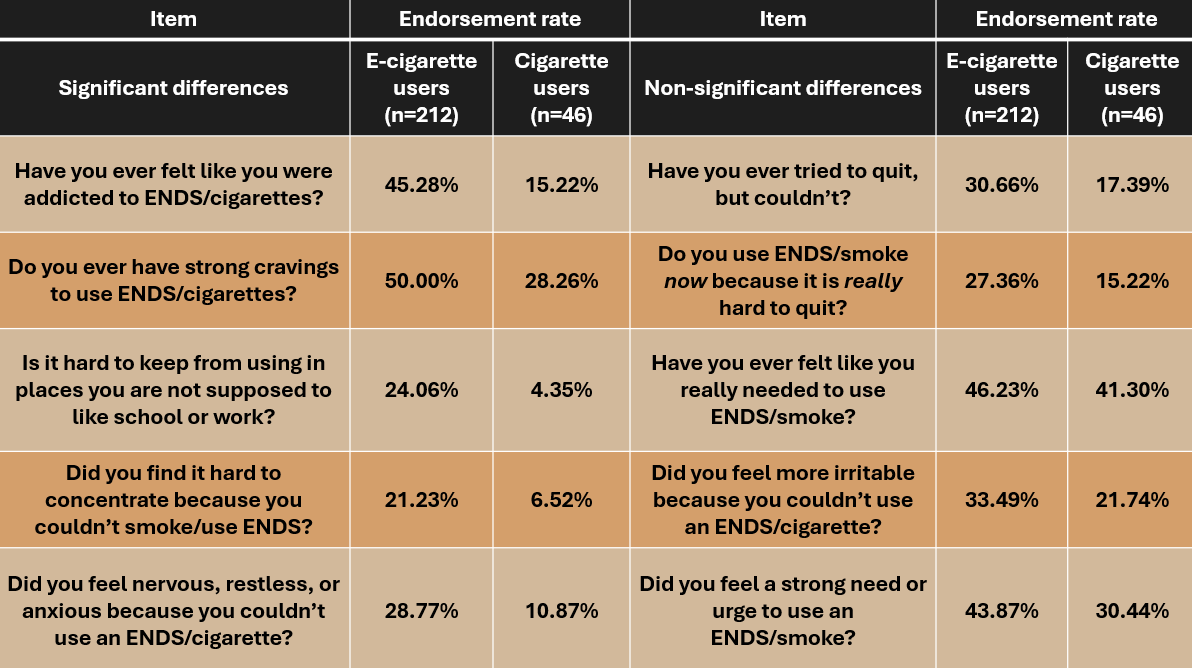Young adulthood is a time when people tend to settle into their substance use patterns. While fewer young adults are smoking cigarettes these days, many are turning to e-cigarettes, which might be more difficult to quit than traditional cigarettes. If so, teens and young adults deserve to know about this risk before they start using e-cigarettes. This week, ASHES reviews a study by Benjamin Cristol and colleagues that compared the addictiveness of e-cigarettes and traditional cigarettes among emerging adults.
What was the research question?
How does the addictiveness of e-cigarettes compare to traditional cigarettes emerging adults?
What did the researchers do?
The researchers used data from the 14th wave of the Texas Adolescent Tobacco and Marketing Surveillance System (TATEMS), a bi-annual longitudinal survey of Texas youth. The survey asked 6th, 8th, and 10th graders about their tobacco use and addiction to nicotine until they reached young adulthood. By the 14th wave, participants were either one, three, or five years removed from high school. To isolate the effects of e-cigarettes and traditional cigarettes, the researchers restricted the sample to exclusive past-30 days e-cigarette users and exclusive past-30 days traditional cigarette users. In other words, participants who reported either dual use, no use of nicotine products, or use of alternative nicotine products (e.g., cigarillos, hookah, cigars) were excluded, leaving a total sample of 258 participants. The researchers used a combination of t-tests and chi-square analyses to compare the addictiveness of e-cigarettes compared to traditional cigarettes. They operationalized addictiveness as the tendency to be dependent on the product’s nicotine.
What did they find?
In terms of screening positive for nicotine dependence, e-cigarette users (59.4%) and traditional cigarette users (47.8%) did not significantly differ from one another. However, they differed with regards to severity of nicotine dependence. Specifically, e-cigarette users reported on average 3.5 symptoms compared to 1.9 symptoms for traditional cigarette users. While all symptoms were elevated among e-cigarette users compared to cigarette users, this was especially true for feelings of being addicted (45.3% vs. 15.2%), the experience of cravings (50.0% vs. 28.3%), difficulty restricting use in prohibited situations (24.1% vs. 4.4%), difficulty concentrating when abstaining (21.2% vs. 6.5%) and of feeling nervous, restless, or anxious (28.8% vs. 10.9%; see Figure).

Figure. Displays the endorsement rate of each nicotine dependence symptom for both e-cigarette and traditional cigarette users. The endorsement rate of statements on the left were significantly different between e-cigarette and traditional cigarette users, while statements on the right did not differ between e-cigarette and traditional cigarette users. ENDS = electronic nicotine delivery systems. Click image to enlarge.
Why do these findings matter?
While some proponents of e-cigarettes tout them as effective harm reduction tools, the findings from this study suggest that e-cigarettes may lead to increased feelings of addiction among emerging adults. Furthermore, though generally regarded as safer than traditional cigarettes, potential emerging negative health effects from vaping coupled with this increased addictiveness throw water on these arguments around vaping for harm reduction. Young e-cigarette users may need more intensive resources to quit, as this study found elevated levels of dependence among e-cigarette users compared to traditional cigarette users.
Every study has limitations. What are the limitations in this study?
Because of the cross-sectional nature of this study, there are two primary limitations. First, because tobacco use was only asked about over the past 30 days, it is unclear how participants’ previous tobacco use might have influenced results. For example, it is possible that some of the e-cigarette users in the sample were former cigarette users and would thus have different clinical profiles. Second, it is unclear how factors such as length of use impact nicotine dependence.
For more information:
Individuals who are concerned about their vaping may find support through the Truth Initiative. Others who want to quit smoking may find advice through the Centers for Disease Control. Additional resources can be found at the BASIS Addiction Resources page.
—John Slabczynski




